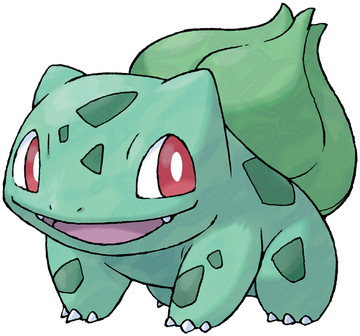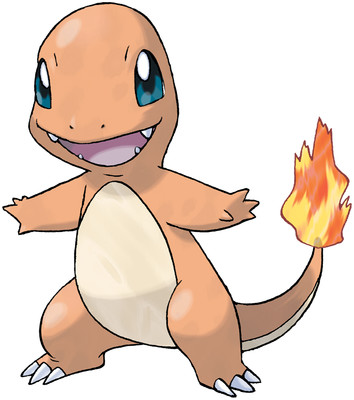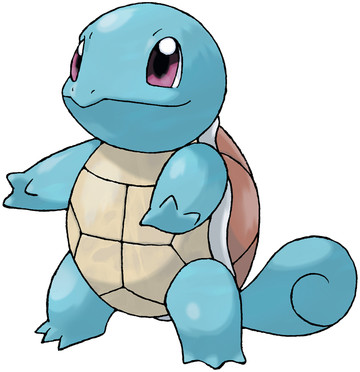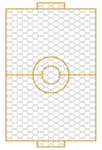GURPS Pokemon Bestiary First Pass
For the past little while, Pseudonym has been posting various Pokemon moves as GURPS Sorcery spells whenever he gets stuck for something else to say.
Along with Smudge’s continuing Pokemon Go adventures, and now the both of us playing the more recent 3DS games, it’s left me wondering just how to emulate the game relationships in a more full fledged system. It’s not too hard for GURPS: each Type is a meta-trait that defines the vulnerabilities and resistances, and then the moves get a type Power-modifier to hook into that.
To keep things from getting absolutely humongous, this is just my general thoughts on how to get the creatures to work, without trying to figure out a proper campaign framework. Don’t expect to see a second pass.
The general Pokemon meta-trait looks like this:
IQ -2 [-40], Hard to Kill 1 [2], Hidebound [-5], Social Stigma (Valuable Property) [-10] = -53
This gives an average Pokemon an IQ of 8 (a bit slow or simple, but quite able to understand what all these humans are doing), and a 6- roll to come up with something new (which is fine out in the wild, where instinct is all you need, but in a Poke-battle against a new opponent you want a trainer calling out instructions). Hard to Kill helps with generally ‘non-lethal’ nature of Poke-fights, but if you want to emulate the setting, you should use as many non-lethal ‘switches’ as possible (no bleeding, no crippling… and possibly rule everything automatically falls unconscious at 0 HP; the TV series especially is a Bonk-only universe).
The brute-force method is to define a meta-trait for each Type with Injury Tolerance: Damage Reduction (2) (Occasional) for each Type ‘not very effective’ against it, and Vulnerability, x2 (Occasional) for each Type that is ‘super effective’ against it, which are worth 20/-20 points each. To emulate the fact that Pokemon are better at moves of their own Type, the meta-trait should also have two levels of [Power] Talent (5 points/level) for the appropriate Type. So a Type is worth 10 points + (very effective – super effective)*20. (As a quick example, Fire Type is 2 levels of Fire Talent [10], Damage Reduction vs Bug, Fairy, Fire, Grass, Ice, and Steel [20 x 6], and Vulnerability to Ground, Rock, and Water [-20 x 3], for a total of 70 points.)
This reverses the normal situation in GURPS, where the limitations on a Power are usually built into the power modifier, but here the meta-trait defines what you’re vulnerable to. While this does get most of the effects (immunities would still be part of the power modifier), they can also be modeled by more general ideas, though they may not be as systemic as this.
The obvious reworks are that Normal Type shouldn’t be a meta-trait at all—they’re just ‘normal’—and Ghost Type includes Insubstantial (Affect Substantial, +100%; Always On, -50%) [120], and most power modifiers include ‘Affects Insubstantial’ for +20%. And the Ground power modifier gets ‘Accessibility: Target is on the Ground, -20%’ (as opposed to ‘Not Flying Type’, which would be the normal way to represent an immunity in the brute-force approach). The odd part is that Ghost Type attacks can’t affect Normal or Fighting (which seems like Insubstantial Only) but do affect everything else, so that’s ‘Affects Substantial (Not Normal, Fighting), +35%’… and have fun explaining it.
Another obvious idea is to have Fighting Types use an actual unarmed MA style, but that’s beyond my GURPS knowledge. Going further, you can start representing a lot of these effects by making sure to build them into the abilities, like representing the vulnerability of Flying Types to Ice simply by making sure that all Ice abilities cause problems for flight (reduced visibility, Side Effects that shut off Flying from icing up, etc.), but that would be relatively tricky.
Purely physical moves (Tackle, Pound, etc.) should be represented with some innate unarmed skill. Moves with low PP scores should cost an FP to use (or more). Optionally, all moves can cost Fatigue (akin to Sorcery), but that’s probably a bit much (and would demand the use of Energy Reserve and the like).
And then the fun part is figuring out the game-stats all the wildly varying physical forms of Pokemon out there. So here’s some sample writeups, that don’t try to account for differences in the in-game stats like speed and attack power:
 Bulbasaur (30 points)
Bulbasaur (30 points)
| ST: 5 [-50] | HP: 5 |
| DX: 10 | Will: 8 |
| IQ: 8 | Per: 8 |
| HT: 10 | FP: 10 |
Basic Speed: 5 Basic Move: 5
SM: -2 2′ 4″ 15 lbs.
Dodge: 8 Thrust: 1d-4 Swing: 1d-3
Pokemon: [-53], Grass Type [-10], Poison Type [70]
Morphology: Cannot Kick [-5], Extra Legs (2; Cannot Kick, -50%) [3]; Vine Whips* [63]
Advantages: Overgrow* [8]
Skills: Brawling DX+2 [4]
Being a Grass/Poison Type means damage done to Bulbasaur is modified as follows:
| Bug | Dark | Drag | Elec | Fair | Figt | Fire | Fly | Ghos | Gras | Grnd | Ice | Pois | Psyc | Rock | Stee | Watr |
| ½ | ½ | ½ | 2 | 2 | ¼ | 2 | 2 | ½ |
*Vine Whips are long, vine-like tendrils that come out of Bulbasaur’s back from underneath the bulb, and serve as its arms with: Extra Flexible, +50%; Long (+5 SM), +500%; Weak (1/2 ST), -25%. They have Reach 2, ST 2, and strike for 1d-1.
*Overgrow provides Bulbasaur 2 levels of Grass Talent whenever his HP is below 1/3.
Powering Up: There is a long list of abilities that Bulbasaur can gain, but we’ll stick with a couple early ones, and present a ‘typical’ level ~13 Bulbasaur. (For those who really are used to the games, note that Vine Whip is built into its morphology, and the Brawling skill represents Tackle.)
Growl: Bulbasaur growls (‘cutely’ by in-game descriptions…) in an effort to intimidate its foes and render them incapable of hitting at full strength. Everyone within a 4-yard radius of Bulbasaur that hears this makes a Will roll to resist or loses 2 Striking ST for the next minute. 18 Points
Affliction 1 (Will; Disadvantage, -2 Striking ST, +10%; Area Effect, 4 Yard Radius, +100%; Based on Will, +20%; Emanation, -20%; Fixed Duration, +0%; Reduced Duration, 1/3, -10%; Sense-Based, Hearing, -20%)
Leech Seed: Bulbasaur fires a seed from his bulb (this costs 1 FP) at his opponent (using Innate Attack (Ranged) + Grass Talent), which if it hits, will attempt to leech HP from the opponent to Bulbasaur. On a hit, the seed will attempt to leech one HP per second (roll a Quick Contest of HT, including Bulbasaur’s Grass Talent, to see if this succeeds) for up to 20 seconds. Every third point of HP successfully leeched will restore one lost HP to Bulbasaur. If the seed can be knocked off the opponent (SM -10), the effect will end at that point. This is a Grass Type ability that can affect an insubstantial target, and the leech is considered Grass-type damage. 78 Points
Leech (Based on HT, Both, +40%; Costs Fatigue, 1FP, -5%; Grass, +20%; Maledicton 2, +150%; Maximum Duration, 20 seconds, -75%; Ranged, +40%; Terminal Condition, -10%) Note: Terminal Condition is not normally allowed for less than a minute, but is given half price here due to the 1-second cycle of the condition.
Poison Powder: Bulbasaur launches a 4-yard radius cloud of spores from his bulb, which spend the next 10 seconds slowly falling to earth. Anyone (Grass Types are immune) who’s skin comes into contact with these spores is poisoned, and must make a HT roll each second for the next 10 seconds, or lose one HP (this is Poison-type damage). 13 Points
Innate Attack 1d (tox; Accessibility, Not Grass Type, -5%; Area Effect, 4-yard Radius, +100%; Contact Agent, +150%; Cyclic, 10 1-sec Cycles, +900%; Emanation, -20%; Persistent, 40%; Poison, 15%; Resistible, HT, -35%)
Adding all of those makes Bulbasaur worth 139 points.
Other Options: Rare Bulbasaurs have Chlorophyll instead of Overgrow (+0.5 Base Speed while in Direct Sunlight, 8 points), though there’s no reason why one couldn’t have both in GURPS. Its first evolution, Ivysaur is physically much the same as Bulbasaur (not always true with Pokemon…), but is a bit larger, having ST & HP 6 instead of 5 for +10 Points. The third form, Venusaur, is much larger, with ST/HP 12, and is SM +1. Reduce the Vine Whips to four levels of Long for SM +5 and Reach 6 (ST is 6), for a total base cost of 88.
And then there’s lots and lots of available moves for any of these creatures to learn.
 Charmander (-34 points)
Charmander (-34 points)
| ST: 5 [-50] | HP: 5 |
| DX: 10 | Will: 8 |
| IQ: 8 | Per: 8 |
| HT: 10 | FP: 10 |
Basic Speed: 5 Basic Move: 5
SM: -2 2′ 19 lbs.
Dodge: 8 Thrust: 1d-4 Swing: 1d-3
Pokemon: [-53], Fire Type [70]
Morphology: Blunt Claws [3], Tail (Striker, cr; Clumsy -20%; Limited Arc, Rear, -40%) [2]; Vulnerability* (Anything that extinguishes fire, 2x; Tail Tip Only, -40%) [-18]
Advantages: Blaze* [8]
Skills: Innate Attack DX+0 [4]
Being a Fire Type means damage done to Charmander is modified as follows:
| Bug | Dark | Drag | Elec | Fair | Figt | Fire | Fly | Ghos | Gras | Grnd | Ice | Pois | Psyc | Rock | Stee | Watr |
| ½ | ½ | ½ | ½ | 2 | ½ | 2 | ½ | 2 |
*Charmander’s life force is reflected in a flame at the tip of his tail. If it ever goes out, he will die (and vice versa). This is only a special effect, except that water hitting the tail, or deliberate attempts to extinguish the flame do double damage.
*Blaze provides Charmander 2 levels of Fire Talent whenever his HP is below 1/3.
Powering Up: Again, there is a long list of abilities that Charmander can gain, but we’ll stick with a ‘typical’ level ~13 Charmander. (Note that the claws and Innate Attack skill represent Scratch.)
Ember: Charmander breathes out a hot ember that hits as a 1d burning attack (Fire Talent applies to the to hit roll) with 1/2D 10, Max 100, Acc 3. It can ignite flammable objects, and affect Insubstantial targets. 6 points
Innate Attack 1d (burn; Fire, +20%)
Growl: Charmander growls (‘cutely’ by in-game descriptions…) in an effort to intimidate its foes and render them incapable of hitting at full strength. Everyone within a 4-yard radius of Charmander that hears this makes a Will roll to resist or loses 2 Striking ST for the next minute. (See Bulbasaur for ability stats.) 18 Points
Dragon Rage: Charmander unleashes all his primal rage in a ranged attack that costs him 1 FP and always does exactly 20 crushing damage if it hits (1/2D -, Max 100, Acc 3) modified by resistances to Dragon Type damage. It does affect insubstantial targets, though Fire Talent does not help with this attack. 36 points
Innate Attack 6d-1 (cr; Dragon, +15%; Costs Fatigue, 1 , -5%; Fixed Roll, +0%; Increased 1/2D, x10, +15%)
Smokescreen: Charmander lets loose a gust of breath that goes to the point he desires and then expands into a two-yard radius cloud of smoke. This smoke causes a -1 vision penalty to all sight into or through the cloud except for Charmander, and lasts for 10 seconds. 4 points
Obscure 1 (Vision; Defensive, +50%; Ranged, +50%)
Adding all of those makes Charmander worth 30 points.
Other Options: Its first evolution, Charmeleon, is physically much the same, but is a bit larger, having ST & HP 7 instead of 5 for +20 Points. The third form, Charizard, is much larger, with ST/HP 12, and is SM 0. It also gains Winged Flight and Flying Type for a grand total of 140 points. Charizard also has a pair of Mega Evolutions available, one of which (Mega Charizard X) trades out Flying Type for Dragon Type for another 20 points.
 Squirtle (-6 points)
Squirtle (-6 points)
| ST: 5 [-50] | HP: 5 |
| DX: 10 | Will: 8 |
| IQ: 8 | Per: 8 |
| HT: 10 | FP: 10 |
Basic Speed: 5 Basic Move: 5
SM: -3 1′ 8″ 20 lbs.
Dodge: 8 Thrust: 1d-4 Swing: 1d-3
Pokemon: [-53], Water Type [50]
Morphology: Amphibious [10], Hard Shell* [19], Tail* [6]
Advantages: Torrent* [8]
Skills: Brawling DX+2 [4]
Being a Water Type means damage done to Bulbasaur is modified as follows:
| Bug | Dark | Drag | Elec | Fair | Figt | Fire | Fly | Ghos | Gras | Grnd | Ice | Pois | Psyc | Rock | Stee | Watr |
| 2 | ½ | 2 | ½ | ½ | ½ |
*Hard Shell: Squirtle has a tough, hard, turtle-like shell that he can withdraw into. This is considered DR4 (Torso Only, -10%) + Alternate Advantage: DR4 (Eyes Also, +5%; Temporary Disadvantage: Quadriplegic, -80%; Temporary Disadvantage: Tunnel Vision, -5%).
*Tail: Squirtle’s tail is capable of causing bruising that makes it slightly harder to move around, and lowers all active defenses by one. This is Striker (cr; Clumsy -20%; Limited Arc, Rear, -40%; Side Effect, -1 Defense Bonus, +80%) [negative defense should probably be more expensive than the +30% of normal Defense Bonus]
*Torrent provides Squirtle 2 levels of Water Talent whenever his HP is below 1/3.
Powering Up: Again, there is a long list of abilities that Squirtle can gain, but we’ll stick with a ‘typical’ level ~13 Squirtle. (Note that the Brawling skill represents Tackle, and tail’s side effect is Tail Whip.)
Bubble: Squirtle breathes out a stream of small water bubbles that hits as a 1d crushing attack (Water Talent applies to the to hit roll) with 1/2D 5, Max 50, Acc 3. The water provides a slick surface that slows down the opponent as he has to keep a firm grip on everything. The target must make a HT roll each time he is hit or lose 0.25 Basic Speed for one minute/MoF (DR adds to this roll if the attack did not penetrate it). This last, naturally, only works if the opponent is not already in water. 55 points
Innate Attack 1d (cr; Water, +20%; Reduced Range, 1/2, -10%) + Affliction (HT; Disadvantage: -0.25 Basic Speed, +5%; Accessibility: Not in Water, -5%; Cumulative, +400%; Follow Up, -10%)
Water Gun: Squirtle shoots a jet of water from his mouth, doing 1d crushing with double normal knockback. This is treated like a melee attack with a Reach up to 10; there is no Acc or ranged modifiers, but it does do 1/2 damage past 5 yards. 7 points
Innate Attack 1d (cr; Water, +20%; Double Knockback, +20%; Jet, +0%)
Adding both of those makes Squirtle worth 56 points.
Other Options: Rare Squirtles have Rain Dish instead of Torrent (Very Fast Regeneration while in rain, 60 points), though there’s no reason why one couldn’t have both in GURPS. Its first evolution, Wartortle, is physically much the same as Squirtle, but is a bit larger, having SM -2 and ST & HP 7 instead of 5 for +20 Points. The third form, Blastoise, is much larger, with ST/HP 11, and is SM +0. The tail is too small to be a striker, so remove it, but water attacks come from a pair of water cannons on the shell instead of its mouth; add Extra Attack (Ranged Water Moves Only, -25%) [19] for a total of 129 points.
Further Thoughts: Of the basic three, Squirtle is supposed to be more defensively oriented, which the DR and shorter-range attacks do fairly well. Charmander should be more offense-oriented, which only shows up with the off-type, but high damage, Dragon Rage here. Giving him some extra ST for his size is a definite option.
Given the generally small size of Pokemon, I rated attacks at 1d per 40 power, which still means unconsciousness checks after one or two hits. Fatigue costs come in at 15 PP.
And, just because it wasn’t hard for me to do, have a 300 dpi GURPS map of a smallish poke-arena. I’m afraid it’s a little bigger than two 11″x17″ sheets so it will take a bit of tiling together to print out. (The colors are reversed from dirt brown with chalk-white lines to reduce ink expenditures….)


Discussion (6) ¬
Cool!
I just looked at your talk about vulnerability meta-traits. A long time ago, I made this worksheet for calculating their values.
http://pseudoboo.blogspot.com/2016/02/ability-elemental-rock-scissors-paper_8.html
I think I might redo it with Damage Reduction instead.
Basically it uses the concept of the accessibility limitation against a vulnerability disadvantage and DR advantages. It might be helpful.
One of the things that had me happy about my version is I skipped Accessibility. I know I would have ended up calculating how much they were all worth by looking up how many of each type there is out of the current total of 721. It also gave me nicely symmetrical numbers.
Looking things over, I’m really tempted to give the Ground, Rock, Steel set Homogenous with universally good DR, and get rid of the Damage Reduction list (especially for Steel with 9 Types on it!). Fighting and other types would pick up Armor Divisor in the power modifier.
I kind of figure Fighting types have a MA style that lets them take ‘normals’ lunch money (nothing else gets a disciplined style); I don’t know how to prevent them from then doing it to everything else. Possibly just the existence of more ranged options in the other Power lists.
…And I said I wasn’t doing a second pass….
Nice, this is actually pretty close to the idea I had for my Pokemon.
Sorry for not being able to add much feed back on your idea for a Pokemon collaboration, my work and life in general has been very counter productive to working on my side post ideas as of late. Hell the last two GURPSday post have literally been written last minute because of this.
Well, real life always has to come first.
I purposefully stayed away talking much about what a Pokemon-like campaign would look like, and I hope you might share some thoughts on that in the future. 🙂 (I could use them.)